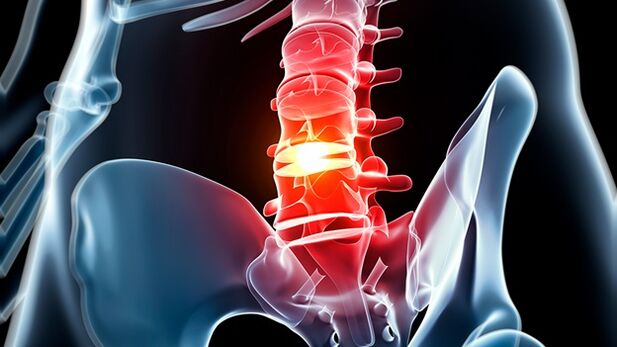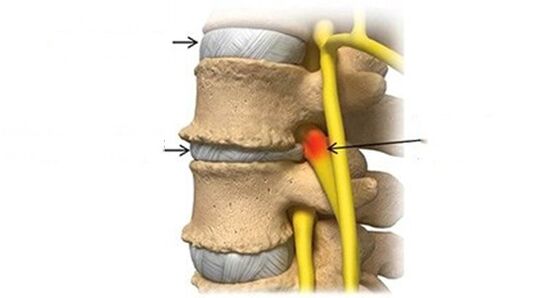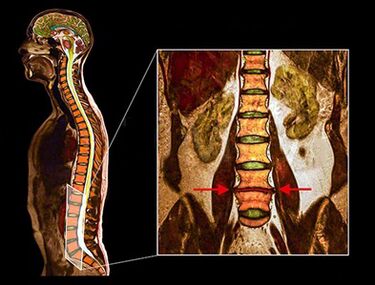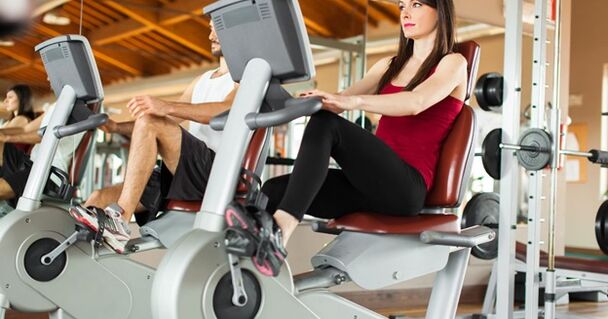In the lumbar spine or the lower back, it is due to innovation changes in discs, leading to lower pain.
The intervertebral discs are hard, fibrous structures that act as a ligament between the vertebrae, absorb stroke and ensure the spine's stroke.The discs are flexible but strong enough to facilitate movement, such as the body's decision, forward, back or side.
Despite the name, osteochondrosis is not considered a real disease and does not deteriorate over time.The discs, as well as all the structures of the body, the degradation and the disk degeneration, develop in all people, as part of the involutionary process.
A typical feature of osteochondrosis is the gradual decrease in symptoms when the spine begins to stabilize.Treatment of osteochondrosis of the lumbar spine focuses on minimizing pain, stabilization of the spine and improving or maintaining mobility.
Symptoms

Most of the osteochondrosis of the lumbar spine must be a mild, constant back pain, which increases from time to several days.
Symptoms may vary, but the most typical are:
- Moderate, constant lower back pain.The pain in the injured disk is the most common symptom of the disc degeneration.Pain can spread to the buttocks, groin and thighs.This pain is usually felt stupid and the intensity can vary from light to severe.
- Periodic acute pain episodes.Back pain can be enhanced for several days or seven and then return to a moderate level.The outbreak of pain occurs as degeneration and relief as the spine gradually stabilizes.The outbreak of pain can occur suddenly, and pain manifestation often leads to a reduction in mobility.
- Local pain.The lower part of the back surrounding the degenerate disc may be sensitive to the touch.Local pain is caused by inflammation and muscle tension in the area of degeneration damaged.
- Foot pain.Neurological symptoms, including numbness, weakness, or sharp shooting in the buttocks, thighs, and/or the back of the leg, can be felt when the height of the disc is significantly reduced and the conditions of the nerve root are occurring.The pain of the legs associated with osteochondrosis of the lumbar spine usually does not fall under the knees.
- A feeling of sudden weakness or instability can occur when the dial is significantly weakened and the patient feels as if the lower back is not working properly.
In addition, pain with certain movements or certain postures such as:
- Pain sitting.For a long time, session often causes lower back pain and stiffness to get worse and relieve a position or change positions.
- Increased pain during bending or rotation.The spine screw and forward, back or side bending can cause intense pain in the damaged disk.
- Reduced pain when changing or changing the situation.When the spine changes, pressure on discs is reduced or redistributed from discs to muscles and joints.Changing positions, alternating between position and sitting and short walks can help relieve stiffness and minimize pain.
Disczegeneration should not cause symptoms of intestinal/bladder dysfunction, fever back pain, inexplicable and rapid weight loss or intense abdominal pain.These symptoms indicate more severe conditions and often require surgical treatment.
Related symptoms
Osteochondrosis of the lumbar spine may also occur in addition to lower back pain.For example:
- Proteins inside the plate can cause significant inflammation if they come into contact with the surrounding spinal structures, and this inflammation can lead to the lower back muscles and radial pain in the hips and on the back of the lower limbs (also known as Ishias).
- Degeneration of the lumbar plate can contribute to the formation of lumbar stenosis and / or lumbar osteoarthritis and other conditions at the lower back.
- The degenerate disc can also lead to the appearance of lumbar intervertebral disk hernia.Neurological symptoms with a disk hernia may be acute and intense.
- In the lumbar spine, the symptoms caused by the degeneration of the plate may vary greatly depending on how quickly or completely the plate has passed through degeneration and how it affects the surrounding spinal structures.
- Pain for osteochondrosis is usually caused by deformation of muscles, which support the spine and inflammation around structures close to the disc.
The causes of osteochondrosis of the lumbar spine
Osteochondrosis occurs due to age wear and disorder disorders, and degeneration process may accelerate due to injury, general condition, health and lifestyle, and is likely to be a genetic predisposition to pathological processes in the muscle bone system.

Osteochondrosis rarely begins with serious injury, such as a car accident.It is more likely that the start of degenerative processes is related to low -energy discs.
Legislation related to lumbar osteochondrosis is generally generated by one or more abnormal processes:
- Inflammation, proteins from the plate are irritated by the surrounding nerves - both small nerves in the disc itself, and potentially large nerves that go to the legs (sciatic).
- Micro abnormal instability, when the exterior rings of the plate, called the fibrous ring, are worn out and cannot effectively absorb the spinal power vector, which leads to movement along the spine segment.
- For a long time, the pain of osteocondrosis of the lumbar spine will eventually decrease and will not be worse.This pain is alleviated because the plate completely damaged by degeneration no longer has inflammatory proteins (which can cause pain) and the sleep plate is in a stable position, eliminating the pain-causing micro movement.
Risk factors
Lifestyle factors that affect overall health can affect the discs between the vertebrae.The risk factors for degenerative disc disease (osteochondrosis) are as follows:
- Family history of back pain or skeleton and muscle disorders
- Excessive load on the back of the back, due to the nature of sports or work
- Long static loads on plates due to long -lasting seats and / or bad posture
- Lack of plates due to weak back muscles
- Obesity
- Smoking or any form of nicotine consumption
Disk degeneration is part of body aging, but not all people suffer from pain or special symptoms.Symptoms usually occur in case of instability, muscle tension and possibly irritation of nerve root.
Diagnosis
- The history of the disease involves a detailed examination, intensity and pain in pain with the load or position of the body.Information is required about regular physical activity, sleep habits and past injuries.
- Physical examination is required to study the range of movements and the condition of the muscle.We also determine the presence of painful areas on palpation or physical disorders.In addition, neurological studies are performed to determine the neurological deficiency.
- The above diagnostic methods are usually sufficient to diagnose osteochondrosis, but the use of display methods is required.
- CT
- Radiography
- MSCT
- Pickling
- MRI - This diagnostic method allows you to clarify the degree of degeneration, the presence of fractures, and the stenosis disk.Often an MRI examination is needed to prepare the surgical treatment to accurately determine the location of the degenerate disk and to plan the surgery.

Studies have shown that the results of MRI with degeneration of moderate or significant plate are found during patients scanning, both with severe pain, minimal or lack of pain.In addition, many painful conditions do not appear on MRI.Therefore, the diagnosis cannot be made exclusively based on the results of the display, and the diagnosis is only possible based on the sum of all clinical and instrumental test methods.
Treatment
The initial methods of treating osteochondrosis of the lumbar spine and pain are usually included in the following combinations:
- Overcompense analgesics They can reduce inflammation, which contributes to the discomfort, stiffness and irritation of nerve roots.
- Prescription painkillers- In the event of severe pain, muscle relaxants or drug reliefs can be prescribed.These drugs are usually used to treat intensive acute pain, which is expected to last more than a few days or weeks.These drugs can cause addiction and cause severe side effects and should be used with caution.
- Warm and ice- The use of heat in the lower back improves blood circulation, which reduces muscle cramps and tension and improves mobility.Ice packs can reduce inflammation and relieve moderate pain.It is useful to use heat before physical exercises to relax the muscles and use ice after physical activity to minimize inflammation.
- Hand therapy. Whose manipulation is performed by a specialist, a popular method of controlling pain when lower back pain.Exercise of doctors, handherapists with their hands affects various areas of the body to reduce the tension of the muscles and joints.It has been found that manipulations are effective measures for temporary pain relief and in some cases as effective as medication.
- Massage- Exposure by massage methods can reduce tension and cramps to the lower back muscles, reduce pressure on the spine and relieve pain.In addition, therapeutic massage can improve blood circulation, ensuring the entry of nutrients and oxygen to tense muscles.
- Epidural injections of steroids- Introduction of a steroid into the spine can reduce pain pulses and inflammation.Injection of the steroid can be used in combination with the physiotherapy program to relieve pain during physical exercises and rehabilitation.As a general rule, the epidural injection of steroids allows pain for a few weeks for a year.
In many cases, effective anesthesia require a combination of treatment methods.The process of test and error usually requires choosing a treatment that turns out to be most effective.
There is no recommended long bed, and in general, immobilization is possible with severe pain for a short period of time, as the lack of physical activity can lead to the weakening of the muscles and the normal spinal support of the spine.
Practical therapy and modification of activity

Physical exercises are needed to maintain healthy mobility of the spine.A lumbar spine's effective exercise program should include:
- Exercises for the lower back, hips and pelvis muscles, and damage to the muscles.The seal of these muscles increases the pressure on the lumbar spine and contributes to the lower back pain.
- The power exercises of the lower and abdominal muscles allow you to maintain a good posture and it is better to maintain the spine.The program for strengthening muscles may include an individual exercise therapy program, the dynamic stabilization of the lumbar spine, Tai-Chi, Pilates or others.
- Low -load aerobic exercises that increase the frequency of heart contractions improve blood circulation and provide nutrients and oxygen, which is needed to restore body tissues.For example, there can be walking, swimming and water aerobics.
Physical exercises programs are usually adapted in each case, depending on the general health condition, the severity of pain and personal preferences.
In addition, small adjustments to everyday activities (modifying lifestyle) can effectively soften pain.For example, when we dress a corset when raising weights or raising weights, you can prevent increased pain due to excessive loads of discs.The use of ergonomic chair and orthopedic mattress can improve posture and reduce plates on plates.
Surgery
Surgery for osteochondrosis of the lumbar spine is required in cases where conservative treatment was not effective for 6 months.The surgical treatment of osteochondrosis is always selective, which means that the patient himself decides whether the operation must be done or not.
We recommend that you consider all the factors before deciding on osteochondrosis surgery, including the duration of the healing period, the treatment of pain during the healing and the rehabilitation of the spine.
The fusion of the vertebrae
Standard surgical treatment of osteochondrosis of the lumbar spine is a union surgery in which two vertebrae are filled together.The purpose of the merger (Spondylodeza) is to reduce pain and to eliminate instability in the motor segment of the spine.
All spinal fusion operations are as follows:
- The damaged disk is completely removed from the intervertebral space (discoCtomy).
- Stabilization is performed with bone transplantation and / or tools (implants, plates, rods and / or screws).
- The fuse of the vertebrae then forms a solid, motionless structure.Fighting within a few months after the procedure and not during surgery.
After surgery, after wearing the corset, painkillers are prescribed.The exercises are very carefully connected to each other, taking into account the unique characteristics of the patient and the degree of tissue regeneration.Complete healing after the merger can take up to a year until the vertebrae grow together.
Surgical replacement of artificial disc
In recent years, the replacement of the damaged disk with artificial implant has been developed as an alternative to merger.The disk replacement operation consists of complete removal of the discoctomy disabled, the restoration of the disk space to the natural height and the implantation of an artificial disk.
This procedure is designed to maintain spine movement, similar to natural movements, reducing the likelihood of increasing pressure on adjacent spine segments (a fairly common complication of spine fusion).
Post -disc recovery usually lasts for 6 months.






















